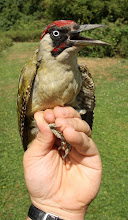The Wash Wader Ringing Group is known around the world in the 'ringing world.' For more information about it please visit
http://www.wwrg.org.uk/At the beginning of August & on the high tides, they have the traditional mini-wash week (Saturday to Tuesday catching). I only had transport for Saturday to Sunday morning catches before picking my Dad up at the airport on Sunday evening so I took in 3 tides.
It was a highly interesting experience from beginning to end. Unfortunately, I accidentally deleted the photographs of the first catch of Sanderling from the camera before I copied them. I did manage to keep a short film of a cannon net firing) and if I can work out how to, I will put it on the blog somewhere. The Sanderling catch (we were up at 3.15am) on the Saturday morning and film of us ringing the birds will be on BBC1's The One Show on 5th September.
The second catch was on Friskney marsh on the Lincolnshire coast. What I wasn't expecting was to have to hide under tarpaulin for 2 hours waiting for the birds to come in & for optimal catching conditions before the tide came in too far!! As you will see from the photo's below, there is no cover near where we were catching the birds.
It is absolutely necessary for us to be near the cannon nets when they fire because we are catching in/near water with a rising tide. This is so we can sprint to the nets once they are fired and make sure that the birds are safe. We also needed to make sure we were far enough away & hidden from view of the birds so that they don't fly away. This was achieved by hiding under a tarpaulin.

Above: Getting ready to hide under the tarpaulin. We were under there for nearly 2 hours! It was very uncomfortable lying on my front & therefore I was slow & stiff on the sprint to the nets. I learnt not to lay on my front! We caught 11 Redshank on this occasion.

Above: Friskney Marshes - we caught 11 Redshank out in the middle of the marsh.
Once the birds were caught, a very swift retreat was in order as the tide was still rising!

Above: A Redshank with a ring on its leg.

Above: A happy grin!
On the Sunday morning (up at 4am), again on the Lincolnshire coast, we had a catch of c.80 Dunlin & c.80 Knot (see next post) & 1 Curlew Sandpiper. Had the wind direction & tide been absolutely optimal, we could have caught 2 or 3 times as many birds).
This was near Gibraltar Point & right on the edge of the salt marshes. For a while, at high tide, we were totally isolated on a small island! We would not have been there had the expected tide been higher - we knew before hand the height of the tide & knew we would be safe.

Above: I briefly handled this Curlew Sandpiper still in summer plumage.



































